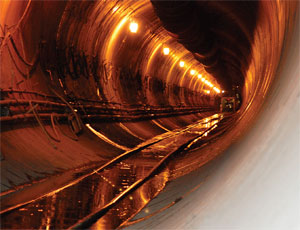Milwaukee is spending $100 million on a metropolitan flood-control project, hoping to avoid future flood damages that have cost that much since 1997. The centerpiece of the plan is a 17-ft-diameter, half-mile-long tunnel that will drain up to 3,405 cu ft per second of water from a flood-prone creek into a 315-million-gallon detention basin.
When heavy rain causes nearby Underwood Creek to overflow, the new tunnel will drain the excess water to a 65-acre engineered detention basin that will slowly release the collected stormwater into the Menomonee River.
Stormwater modeling predicts the basin could fill in about four hours, but the structure would release the water into the river over a four-day period.
The new tunnel, the basin and the discharge system are part of the Milwaukee Metropolitan Sewerage District’s $100- million flood-control project, which is called the “county grounds” project. It is the largest component in MMSD’s $300-million overall flood-control system, which includes four other projects along the Menomonee River and its tributaries. MMSD and its consultants looked at 17 possible solutions before choosing the best combination of projects, says Tom Chapman, MMSD section manager.
“Homes and businesses damaged by floods in this area were not in the flood plain when built,” says Chapman, “but now they are because the floodplain has grown.” MMSD estimates that flood-related damages in the drainage area total more than $100 million since 1997.
MMSD designers made a big impact by restoring Underwood Creek’s route to its natural meander, sloping its banks and putting in the tunnel to drain flood overflow into the county-grounds detention basin.
“During flooding, this [tunnel] project will cut the flow of Underwood Creek in half,” says Chapman.
Shea/Kenney, the Milwaukee-based joint-venture general contractor, is building a 25-ft-wide, 260-ft-long, three-story-deep in-ground inlet near the creek, boring and lining the 2,722-ft-long tunnel, building the aboveground concrete walls where the tunnel empties into the basin and building six outlet boxes that release water from the basin into the river.
Shea/Kenny is mining the tunnel with a laser-guided earth-pressure-balanced tunnel-boring machine. Boring started from the basin and is going uphill toward the creek, opposite of the way floodwater will flow.
“The system is designed so that water keeps working its way downhill, from the inlet through the tunnel into the basin and out the other end into the river. No pumps or human action is needed,” says Liesel Geyer Gilmere, project manager for Cambridge, Mass.-based CDM, MMSD’s on-site representative.
“The designers figured that if we were having an extremely severe storm, we’d probably have power failures and other utility problems. So they designed [a gravity-flow] system,” she says.
The TBM’s rotating head cuts a 19-ft 2-in. bore through the site’s silt, sand, clay, gravel, cobbles and boulders. Conveyors move excavated earth and rock to a small-gauge train that shuttles away 12-cu-yd carloads of muck for use at another site.
Shea/Kenny is lining the tunnel with precast concrete rings that come in six sections each. As the TBM cuts the tunnel, crews inside the machine assemble the newest ring of concrete liner, then pump grout through one-way valves to fill the void between the liner and the tunnel’s dirt wall. Each finished ring has a 17-ft inside diameter and is 4 ft long.
Before boring began, at each end of the tunnel, a subcontractor excavated a cube 40 ft on a side and filled it with a bentonite-fly-ash mixture to make a solid mass of 200-psi soft concrete. This “ground conditioning” established a platform for a solid, precisely aligned start and finish to the tunnel, explains Len Postregna, Shea/Kenny’s project manager. In addition, says Postrenga, the tunnel’s end liner sections will be held in place with concrete, instead of grout.
Tunnel boring started in December and will be complete by mid-April.
Other parts of the county-grounds project will continue into next year.



Post a comment to this article
Report Abusive Comment